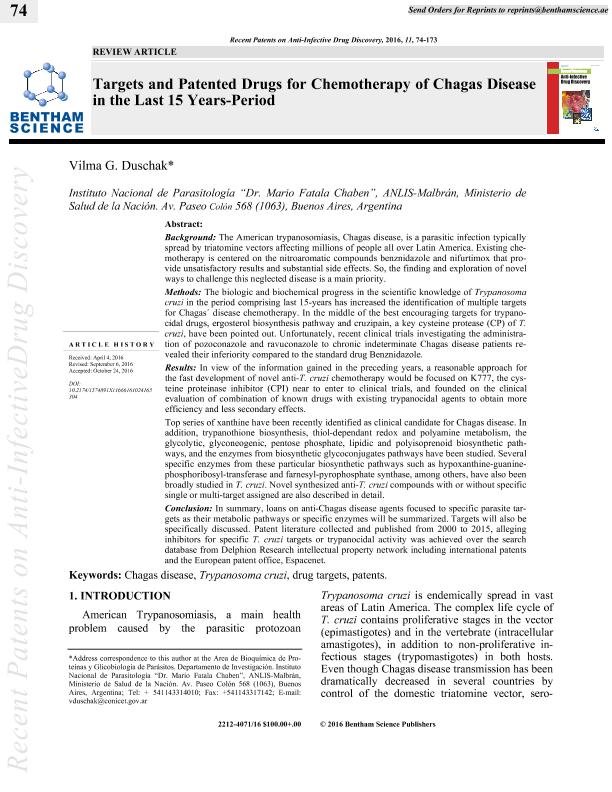Mostrar el registro sencillo del ítem
dc.contributor.author
Duschak, Vilma Gladys

dc.date.available
2022-11-28T18:09:42Z
dc.date.issued
2016-12
dc.identifier.citation
Duschak, Vilma Gladys; Targets and patented drugs for chemotherapy of chagas disease in the last 15 years-period; Bentham Science Publishers; Recent Patents on Anti-Infective Drug Discovery; 11; 2; 12-2016; 74-173
dc.identifier.issn
1574-891X
dc.identifier.uri
http://hdl.handle.net/11336/179246
dc.description.abstract
Background: The American trypanosomiasis, Chagas disease, is a parasitic infection typically spread by triatomine vectors affecting millions of people all over Latin America. Existing chemotherapy is centered on the nitroaromatic compounds benznidazole and nifurtimox that provide unsatisfactory results and substantial side effects. So, the finding and exploration of novel ways to challenge this neglected disease is a main priority. Methods: The biologic and biochemical progress in the scientific knowledge of Trypanosoma cruzi in the period comprising last 15-years has increased the identification of multiple targets for Chagas’ disease chemotherapy. In the middle of the best encouraging targets for trypanocidal drugs, ergosterol biosynthesis pathway and cruzipain, a key cysteine protease (CP) of T. cruzi, have been pointed out. Unfortunately, recent clinical trials investigating the administration of pozoconazole and ravuconazole to chronic indeterminate Chagas disease patients revealed their inferiority compared to the standard drug Benznidazole. Results: In view of the information gained in the preceding years, a reasonable approach for the fast development of novel anti-T. cruzi chemotherapy would be focused on K777, the cysteine proteinase inhibitor (CPI) near to enter to clinical trials, and founded on the clinical evaluation of combination of known drugs with existing trypanocidal agents to obtain more efficiency and less secondary effects. Top series of xanthine have been recently identified as clinical candidate for Chagas disease. In addition, trypanothione biosynthesis, thiol-dependant redox and polyamine metabolism, the glycolytic, glyconeogenic, pentose phosphate, lipidic and polyisoprenoid biosynthetic pathways, and the enzymes from biosynthetic glycoconjugates pathways have been studied. Several specific enzymes from these particular biosynthetic pathways such as hypoxanthine-guaninephosphoribosyl-transferase and farnesyl-pyrophosphate synthase, among others, have also been broadly studied in T. cruzi. Novel synthesized anti-T. cruzi compounds with or without specific single or multi-target assigned are also described in detail. Conclusion: In summary, loans on anti-Chagas disease agents focused to specific parasite targets as their metabolic pathways or specific enzymes will be summarized. Targets will also be specifically discussed. Patent literature collected and published from 2000 to 2015, alleging inhibitors for specific T. cruzi targets or trypanocidal activity was achieved over the search database from Delphion Research intellectual property network including international patents and the European patent office, Espacenet.
dc.format
application/pdf
dc.language.iso
eng
dc.publisher
Bentham Science Publishers

dc.rights
info:eu-repo/semantics/openAccess
dc.rights.uri
https://creativecommons.org/licenses/by/2.5/ar/
dc.subject
CHAGAS DISEASE
dc.subject
DRUG TARGETS
dc.subject
PATENTS
dc.subject
TRYPANOSOMA CRUZI
dc.subject.classification
Parasitología

dc.subject.classification
Ciencias de la Salud

dc.subject.classification
CIENCIAS MÉDICAS Y DE LA SALUD

dc.title
Targets and patented drugs for chemotherapy of chagas disease in the last 15 years-period
dc.type
info:eu-repo/semantics/article
dc.type
info:ar-repo/semantics/artículo
dc.type
info:eu-repo/semantics/publishedVersion
dc.date.updated
2022-11-25T12:09:59Z
dc.identifier.eissn
2212-4071
dc.journal.volume
11
dc.journal.number
2
dc.journal.pagination
74-173
dc.journal.pais
Estados Unidos

dc.journal.ciudad
Nueva York
dc.description.fil
Fil: Duschak, Vilma Gladys. Dirección Nacional de Instituto de Investigación. Administración Nacional de Laboratorio e Instituto de Salud “Dr. C. G. Malbrán”. Instituto Nacional de Parasitología "Dr. Mario Fatala Chaben”; Argentina. Consejo Nacional de Investigaciones Científicas y Técnicas; Argentina
dc.journal.title
Recent Patents on Anti-Infective Drug Discovery
dc.relation.alternativeid
info:eu-repo/semantics/altIdentifier/url/https://www.eurekaselect.com/article/79213
dc.relation.alternativeid
info:eu-repo/semantics/altIdentifier/doi/https://doi.org/10.2174/1574891x11666161024165304
Archivos asociados
